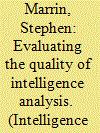| Srl | Item |
| 1 |
ID:
116172


|
|
|
|
|
| Publication |
2012.
|
| Summary/Abstract |
This article addresses the challenge of managing uncertainty when producing estimative intelligence. Much of the theory and practice of estimative intelligence aims to eliminate or reduce uncertainty, but this is often impossible or infeasible. This article instead argues that the goal of estimative intelligence should be to assess uncertainty. By drawing on a body of nearly 400 declassified National Intelligence Estimates as well as prominent texts on analytic tradecraft, this article argues that current tradecraft methods attempt to eliminate uncertainty in ways that can impede the accuracy, clarity, and utility of estimative intelligence. By contrast, a focus on assessing uncertainty suggests solutions to these problems and provides a promising analytic framework for thinking about estimative intelligence in general.
|
|
|
|
|
|
|
|
|
|
|
|
|
|
|
|
| 2 |
ID:
116173


|
|
|
|
|
| Publication |
2012.
|
| Summary/Abstract |
Using newly released and previously unexploited records, this article explores the existence of Anglo-Arab secret liaison and cooperation in instituting anti-communist measures in the early Cold War. It shows that owing to their concern about a war against the Soviet Union, the placing of a British security/police adviser in specific countries was the preferred method by Britain for checking and combatting communism in the Middle East. It argues that the development of the 'anti-communist triangle' (the security liaison between Lebanon, Iraq and Jordan) was largely influenced by British concern about the expansion of communist influence. Moreover, the expansion of British influence in the region also converged with the demands from Middle Eastern countries for a British expert in anti-communist measures. The article implies the importance of the role of secret liaison in historical enquiries.
|
|
|
|
|
|
|
|
|
|
|
|
|
|
|
|
| 3 |
ID:
116174


|
|
|
|
|
| Publication |
2012.
|
| Summary/Abstract |
This study examines the code words and euphemisms which protected Anglo-American communications intelligence (Comint) during the Cold War. It explains how the code word security system operated and identifies the main Comint code words and euphemisms in effect from 1946 to 1999. The article then uses these code words and euphemisms to interpret declassified American documents and reveal more information about Anglo-American Comint on the Congo, Bolivia, Indonesia, South Vietnam and China in the 1960s.
|
|
|
|
|
|
|
|
|
|
|
|
|
|
|
|
| 4 |
ID:
116175


|
|
|
|
|
| Publication |
2012.
|
| Summary/Abstract |
Each of the criteria most frequently used to evaluate the quality of intelligence analysis has limitations and problems. When accuracy and surprise are employed as absolute standards, their use reflects unrealistic expectations of perfection and omniscience. Scholars have adjusted by exploring the use of a relative standard consisting of the ratio of success to failure, most frequently illustrated using the batting average analogy from baseball. Unfortunately even this relative standard is flawed in that there is no way to determine either what the batting average is or should be. Finally, a standard based on the decision-makers' perspective is sometimes used to evaluate the analytic product's relevance and utility. But this metric, too, has significant limitations. In the end, there is no consensus as to which is the best criteria to use in evaluating analytic quality, reflecting the lack of consensus as to what the actual purpose of intelligence analysis is or should be.
|
|
|
|
|
|
|
|
|
|
|
|
|
|
|
|
| 5 |
ID:
116171


|
|
|
|
|
| Publication |
2012.
|
| Summary/Abstract |
We introduce the latest member of the intelligence family. Joining IMINT, HUMINT, SIGINT and others is 'SOCMINT' - social media intelligence. In an age of ubiquitous social media it is the responsibility of the security community to admit SOCMINT into the national intelligence framework, but only when two important tests are passed. First, that it rests on solid methodological bedrock of collection, evidence, verification, understanding and application. Second, that the moral hazard it entails can be legitimately managed. This article offers a framework for how this can be done.
|
|
|
|
|
|
|
|
|
|
|
|
|
|
|
|